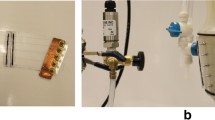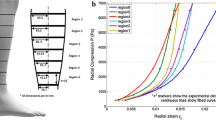Abstract
In this paper, the effect of calf deformation on the performance of an active compression brace (ACB) due to external pressure is investigated experimentally and analytically. The ACB, actuated by shape memory alloy wires, was designed and prototyped for potentially being used in future clinical studies to prevent or mitigate symptoms of lower extremity disorders. In this work, an analytical model is presented to simulate the ACB when wrapped around a calf assumed to be either incompressible or compressible. Furthermore, a physical calf model synced with a controllable syringe pump with a LabVIEW code was used to perform cyclic tests to evaluate the performance of the ACB experimentally in both cases of having a simplified incompressible calf or, more realistically, a compressible calf. The collected experimental data was compared with simulation results obtained from the analytical model. The experimental results showed a significant drop in the actuation pressure produced by the ACB on a deformable calf model compared to an incompressible calf model. The analytical model that was developed accurately predicted such a behavior. In fact, for an initial wrapping pressure of 10 mmHg the maximum deviations between the experimental and analytical results were 1.66 and 0.54 mmHg respectively for the cases of an incompressible and compressible calf. Similarly, for the initial wrapping pressure of 15 mmHg the maximum deviations were found to be 0.52 and 0.73 mmHg respectively. A two-dimensional finite element (FE) model of the leg was also developed to investigate the effect of the applied external pressure on the internal tissue. FE analyses were conducted using different geometrical parameters of the leg including calf, tibia and fibula sizes.










Similar content being viewed by others
References
Coleridge-Smith, P. D. (2009). Leg ulcer treatment. Journal of Vascular Surgery, 49(3), 804–808.
Protheroe, C. L., Dikareva, A., Menon, C., & Claydon, V. E. (2011). Are compression stockings an effective treatment for orthostatic presyncope? PLoS ONE, 6(12), e28193.
O’Meara, S., Cullum, N., Nelson, E. A., & Dumville, J. C. (2012). Compression for venous leg ulcers. The Cochrane Library, 11.
Nelson, E. A., & Bell‐Syer, S. E. (2012). Compression for preventing recurrence of venous ulcers. The Cochrane Library.
Diehm, C., Trampisch, H., Lange, S., & Schmidt, C. (1996). Comparison of leg compression stocking and oral horse-chestnut seed extract therapy in patients with chronic venous insufficiency. The Lancet, 347(8997), 292–294.
Brennan, M. J., & Miller, L. T. (1998). Overview of treatment options and review of the current role and use of compression garments, intermittent pumps, and exercise in the management of lymphedema. Cancer, 83(S12B), 2821–2827.
Doan, B., Kwon, Y.-H., Newton, R., Shim, J., Popper, E., Rogers, R., … Kraemer, W. (2003). Evaluation of a lower-body compression garment. Journal of sports sciences, 21(8), 601–610
Platts, S. H., Tuxhorn, J. A., Ribeiro, L. C., Stenger, M. B., Lee, S., & Meck, J. V. (2009). Compression garments as countermeasures to orthostatic intolerance. Aviation, Space and Environmental Medicine, 80(5), 437–442.
Avril, S., Bouten, L., Dubuis, L., Drapier, S., & Pouget, J.-F. (2010). Mixed experimental and numerical approach for characterizing the biomechanical response of the human leg under elastic compression. Journal of Biomechanical Engineering, 132(3), 031006.
Privett, S. E., George, K. P., Whyte, G. P., & Cable, N. T. (2010). The effectiveness of compression garments and lower limb exercise on post-exercise blood pressure regulation in orthostatically intolerant athletes. Clinical Journal of Sport Medicine, 20(5), 362–367.
Partsch, H., Flour, M., & Smith, P. C. (2008). Indications for compression therapy in venous and lymphatic disease consensus based on experimental data and scientific evidence. Under the auspices of the IUP. International Angiology, 27(3), 193–219.
Jones, N., Webb, P., Rees, R., & Kakkar, V. (1980). A physiological study of elastic compression stockings in venous disorders of the leg. British Journal of Surgery, 67(8), 569–572.
Pierson, S., Pierson, D., Swallow, R., & Johnson, G. (1983). Efficacy of graded elastic compression in the lower leg. JAMA, 249(2), 242–243.
Brandjes, D. P., Büller, H. R., Heijboer, H., Huisman, M. V., de Rijk, M., Jagt, H., et al. (1997). Randomised trial of effect of compression stockings in patients with symptomatic proximal-vein thrombosis. The Lancet, 349(9054), 759–762.
Downie, S. P., Raynor, S. M., Firmin, D. N., Wood, N. B., Thom, S. A., Hughes, A. D., … Xu, X. Y. (2008). Effects of elastic compression stockings on wall shear stress in deep and superficial veins of the calf. American Journal of Physiology-Heart and Circulatory Physiology, 294(5), H2112–H2120
Ginsberg, J. S., Hirsh, J., Julian, J., Vander LaandeVries, M., Magier, D., MacKinnon, B., et al. (2001). Prevention and treatment of postphlebitic syndrome: Results of a 3-part study. Archives of Internal Medicine, 161(17), 2105–2109.
Kanaan, A. O., Lepage, J. E., Djazayeri, S., & Donovan, J. L. (2012). Evaluating the role of compression stockings in preventing post thrombotic syndrome: A review of the literature. Thrombosis, 2012.
Walker, L., & Lamont, S. (2007). The use of antiembolic stockings. Part 1: A literature review. British Journal of Nursing, 16(22), 1408–1413.
Pedegana, L. R., Burgess, E. M., Moore, A. J., & Carpenter, M. L. (1977). Prevention of thromboembolic disease by external pneumatic compression in patients undergoing total hip arthroplasty. Clinical Orthopaedics and Related Research, 128, 190–193.
Silbersack, Y., Taute, B.-M., Hein, W., & Podhaisky, H. (2004). Prevention of deep-vein thrombosis after total hip and knee replacement low-molecular-weight heparin in combination with intermittent pneumatic compression. Journal of Bone & Joint Surgery, British, 86(6), 809–812.
Madden, J. D., Vandesteeg, N. A., Anquetil, P. A., Madden, P. G., Takshi, A., Pytel, R. Z., … Hunter, I. W. (2004). Artificial muscle technology: physical principles and naval prospects. IEEE Journal of Oceanic Engineering, 29(3), 706–728
Holschuh, B., Obropta, E., & Newman, D. (2014). Low spring index NiTi coil actuators for use in active compression garments.
Dimitris, C. L. (2008). Shape memory alloys: Modeling and engineering applications. New York: Springer.
Moein, H., & Menon, C. (2014). An active compression bandage based on shape memory alloys: a preliminary investigation. Biomedical Engineering Online, 13(1), 135.
Thirsk, R., Kamm, R., & Shapiro, A. (1980). Changes in venous blood volume produced by external compression of the lower leg. Medical & Biological Engineering & Computing, 18(5), 650–656.
Boa Closure System. (2016). Retrieved from http://www.boatechnology.com/.
Technical Characteristics of Flexinol Actuator Wires. (2016). Retrieved from www.dynalloy.com.
Pourazadi, S., Ahmadi, S., & Menon, C. (2014). Towards the development of active compression bandages using dielectric elastomer actuators. Smart Materials and Structures, 23(6), 065007.
Sigvaris Compression Stocking. (2016). Retrieved from http://www.sigvarisusa.com.
Elahinia, M. H., & Ahmadian, M. (2005). An enhanced SMA phenomenological model: I. The shortcomings of the existing models. Smart Materials and Structures, 14(6), 1297.
Brinson, L. (1993). One-dimensional constitutive behavior of shape memory alloys: Thermomechanical derivation with non-constant material functions and redefined martensite internal variable. Journal of Intelligent Material Systems and Structures, 4(2), 229–242.
Moallem, M., & Tabrizi, V. (2009). Tracking control of an antagonistic shape memory alloy actuator pair. IEEE Transactions on Control Systems Technology, 17(1), 184–190.
Liang, C. (1990). The constitutive modeling of shape memory alloys.
Wang, Y., Downie, S., Wood, N., Firmin, D., & Xu, X. Y. (2012). Finite element analysis of the deformation of deep veins in the lower limb under external compression. Medical Engineering & Physics, 35(4), 515–523. doi:10.1016/j.medengphy.2012.06.019.
Belytschko, T., Liu, W. K., Moran, B., & Elkhodary, K. (2013). Nonlinear finite elements for continua and structures. Hoboken: Wiley.
Mase, G. T., Smelser, R. E., & Mase, G. E. (2009). Continuum mechanics for engineers (3rd ed.). Boston: CRC Press.
Moein, H., & Menon, C. (2015). Parametric study on an active compression bandage performance. Presented at the International Conference on Smart Materials and Structures, Vancouver, BC, Canada.
Acknowledgements
This research was supported by the Natural Sciences and Engineering Research Council of Canada (NSERC), the Canadian Institutes of Health Research (CIHR) and the Michael Smith Foundation for Health Research (MSFHR).
Author’s Contributions
HM designed and fabricated the ACB, developed the analytical models and simulations, designed the experiments and contributed to the experimental results collection, processed the experimental data, contributed to the FE modeling and analysis and drafted the manuscript. CM contributed to the original concept for the compression brace application, supervised the project, and also contributed to discussions and analysis. MK conducted the FE modeling and contributed to the FE results analysis. US contributed to the experimental results collection. US and SP developed the code in LabVIEW communicating with the syringe pump and set the experimental setup. All authors read, and approved the final manuscript.
Author information
Authors and Affiliations
Corresponding author
Rights and permissions
About this article
Cite this article
Moein, H., Schmill, U., Komeili, M. et al. Effect of the Leg Volume Change on the Performance of an Active Compression Brace Based on Shape Memory Alloys. J. Med. Biol. Eng. 37, 248–261 (2017). https://doi.org/10.1007/s40846-017-0218-4
Received:
Accepted:
Published:
Issue Date:
DOI: https://doi.org/10.1007/s40846-017-0218-4




